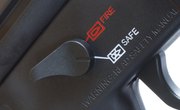Criminals can strike any time, even in broad daylight in the safest of cities. While police usually respond to calls for help quickly, carrying and using a personal defense device can mean the difference between successfully fighting off an attack and being forced to succumb to an attacker. One type of non-lethal device, the stun gun, works by delivering an electrical shock to the attacker to incapacitate him. Stun gun owners should check their device periodically to ensure it is functioning properly. If the device isn't working right, users can perform some basic troubleshooting tasks.
Point the connectors of the stun gun away from yourself or any other person. Press and release the trigger once. Watch for an electrical arc to form between the connectors.
Look for a safety switch on the side of the stun gun. Position the switch to "on," if necessary, then test the gun again.
Check that the safety strap is fully inserted into the stun gun, as some models will not work if the strap is loose. Push the strap's connectors into the gun's body to ensure a snug connection. Test the gun again.
Put the safety switch in the "off" position. Slide open the battery casing and remove the stun gun's 9-volt or lithium battery. Replace the battery with a new one. Alternately, if the gun is a rechargeable model, charge the device according to the manufacturer's instructions. Position the safety switch to "on," then test for an electrical charge.
Call the stun gun's manufacturer if no troubleshooting techniques restore functionality to the gun.
References
Writer Bio
Brad Chacos started writing professionally in 2005, specializing in electronics and technology. His work has appeared in Salon.com, Gizmodo, "PC Gamer," "Maximum PC," CIO.com, DigitalTrends.com, "Wired," FoxNews.com, NBCNews.com and more. Chacos is a frequent contributor to "PCWorld," "Laptop Magazine" and the Intuit Small Business Blog.



